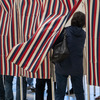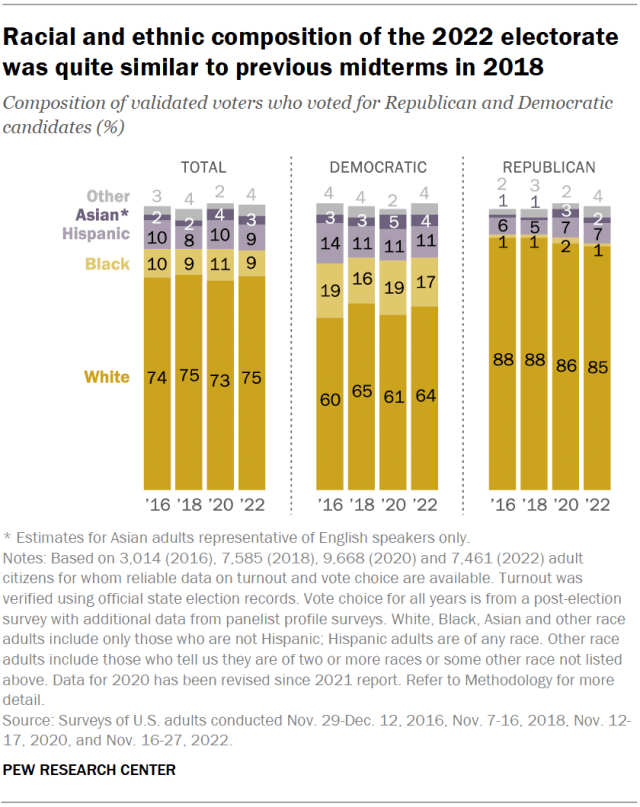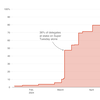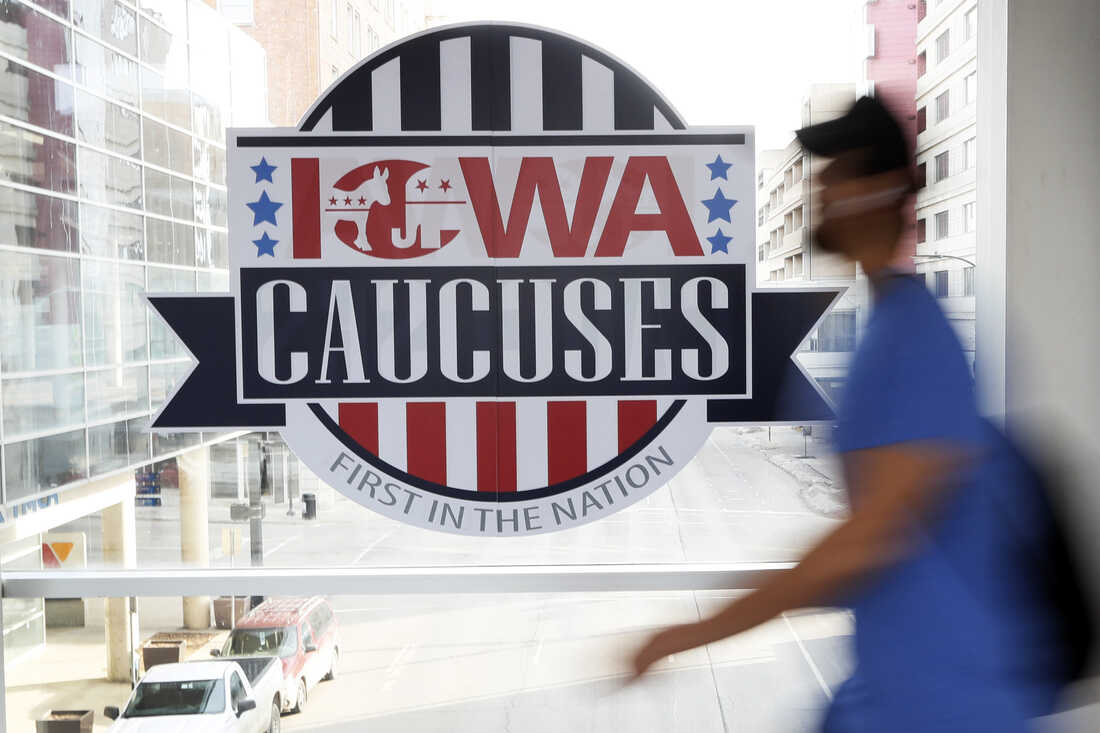
A pedestrian walks past a sign for the Iowa caucuses on a downtown skywalk in Des Moines, Iowa, on Feb. 4, 2020.
Charlie Neibergall/AP
hide caption
toggle caption
Charlie Neibergall/AP
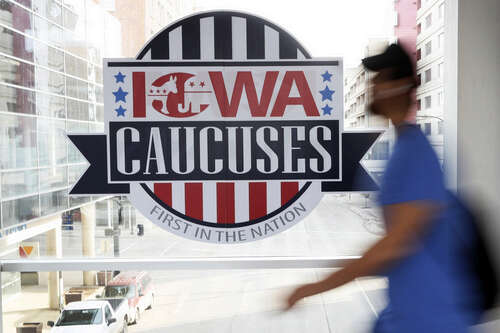
A pedestrian walks past a sign for the Iowa caucuses on a downtown skywalk in Des Moines, Iowa, on Feb. 4, 2020.
Charlie Neibergall/AP
There’s a lot at stake in the Iowa caucuses, which take place Jan. 15.
They mark the official start to the presidential nominating process. They will also test former President Donald Trump’s apparent continued strength among Republicans — and whether anyone else can give him a run for his money.
But why does Iowa dominate the political conversation every four years around this time, and how do the caucuses even work? Let’s explore.
Why is Iowa important?
A dollar out of every $2.50 that has been spent on TV ads so far in the entire 2024 Republican nominating contest has gone toward 30- and 60-second spots in places like Des Moines, Cedar Rapids and Sioux City, the latter of which is a very conservative part of Iowa and a key area for Republicans to mobilize voters, though nonpolitical watchers may have heard of it for its unique airport code.
More than $100 million of the $258 million in ad spending has gone toward Iowa media markets, according to data collected by the ad-tracking firm AdImpact and analyzed by NPR. (AdImpact and NPR have partnered to track ads for the 2024 election.)
So, the point is, the candidates think it’s pretty important. Why so? It’s all about momentum. Candidates, especially those who aren’t front-runners, have used Iowa as something of a launching pad for attention, earned media (having their names mentioned for free in the news) and money.
Barack Obama famously won in Iowa in 2008, which catapulted him in the primary race against Hillary Clinton. On the Republican side, George W. Bush showed his strength there in the 2000 race when he was locked in a tight battle with Sen. John McCain.
But Iowa hasn’t always proved predictive of who the nominee would be. Joe Biden broke precedent, losing both Iowa and New Hampshire but becoming president. And the last three eventual GOP nominees all lost the Iowa caucuses.
Still, it’s hard to be too far out of the top three slots and become the nominee — seven of the eight Republican nominees since 1976 finished in the top three in Iowa (the exception being McCain in 2008). For Democrats, it’s eight of the last 10. (Biden in 2020 and Bill Clinton in 1992 both finished fourth.)
How do the caucuses work?
Iowa Republicans have caucus meetings at 1,657 caucus sites this year. These are essentially party meetings. They have party business they attend to, representatives of each campaign make a short pitch for their candidate and then attendees cast secret ballots.
The GOP caucuses are far less complicated than what Democrats do in the state. Democrats split up and vote by physically gathering with other supporters of a campaign. If a Democratic candidate is below 15%, then that person is eliminated and that candidate’s supporters have to choose someone else.
There’s none of that with Republicans. But the campaigns still need to have strong ground operations to get out the vote, considering the more than 1,600 sites and the ability to pitch voters in person at these sites.
Trump has a much stronger ground game in the state than in 2016, when he lost narrowly. He’s appealing heavily to first-time voters. Almost half of Iowa caucusgoers in 2016 voted in the process for the first time, and they broke for Trump.
This is a closed contest. In other words, voting is open only to registered Republicans in Iowa. There’s certainly room to turn out new voters with a candidate they feel passionately enough about, because only a fraction of Iowa Republicans wind up participating — fewer than 1 in 4 do traditionally.
Why do they use caucuses instead of primaries?
Primaries are far more straightforward. They’re also seen as more accessible, because they don’t take up as much time. If you’re someone with an hourly job, for example, it’s much more difficult to get hours off from work to participate in a caucus on a Monday or Tuesday (although this year’s caucuses are taking place on Martin Luther King Jr. Day, which a lot of people have off — unless, of course, you work in a service industry or retail).
So why opt to use caucuses at all? Well, these nominating contests are, at their heart, party affairs. It wasn’t even always the case that there was direct voting for nominees. There’s still some of that left over, but proponents of caucuses over primaries will say that voters are more engaged.
Rather than simply going in and out of a voting place, caucusgoers have a say in party affairs at the community level. That’s notable when two-thirds of Americans have reported feeling a sense of non-belonging in the country overall and three-quarters said they feel that way in their own communities.
Why is Iowa first?
Traditions can be very hard to change.
Iowa is first only on the Republican side now. Because of Democrats’ results-reporting mishap in 2020, the state was demoted in the Democratic Party’s process.
Iowa Democrats will still hold party caucuses on Jan. 15, but they won’t be voting that day on whom they want for president. That will happen by mail, and the results won’t be known until March 5, the day of the Republicans’ Super Tuesday, when 16 states and territories vote — the largest single primary voting day of the year.
Iowa Democrats’ reporting malfunction in 2020 came at exactly the wrong time for the state, because a growing chorus was questioning why Iowa continued to be first given that its population is overwhelmingly white and not reflective of the country at large — or the Democratic Party’s growing diversity.
Grassroots Republicans haven’t had the same questions about the state. Iowa as a whole is 90% white. About 85% of the Republican Party is white, compared with about 60% or so in the Democratic Party.
None of that answers how Iowa became first, however. It came about in the Vietnam War era and happened, in part, simply because its delegate allocation process was so long.
There were multiple steps to awarding and naming delegates, going from precinct caucuses to county conventions and finally the state convention.
It all took months.
Democrats changed their nominating process to make it more open to rank-and-file voters after the violent 1968 Democratic National Convention in Chicago. They wanted the nominating process over by June, but given how long Iowa’s process took, this wound up putting the state at the front of the line to comply with the national party’s deadline.
The 1972 Iowa caucuses were held in late January. That placed it ahead of New Hampshire, which had been the nation’s first contest for decades. Iowa and New Hampshire struck a deal that said Iowa could hold the first caucuses and New Hampshire the first primary.
The caucuses in 1972 were poorly attended, but the result began the era of beating political expectations. David Yepsen, the former political columnist for The Des Moines Register, wrote about how it all happened:
“A young campaign manager for an obscure presidential candidate that year was Gary Hart and he decided to exploit that decision. He was the leader of South Dakota Senator George McGovern’s presidential campaign. Hart was looking for a way for his candidate to get some media attention before the important New Hampshire primary and thought the vote taken at the Iowa caucuses in 1972 would provide him with that attention. McGovern organized in Iowa and finished close behind Maine Senator Edmund Muskie. That result surprised political reporters and McGovern received his boost of media attention.”
Seeing the attention that the Democrats got, Iowa Republicans followed suit, holding their caucuses on the same night as the Democrats beginning in 1976.
